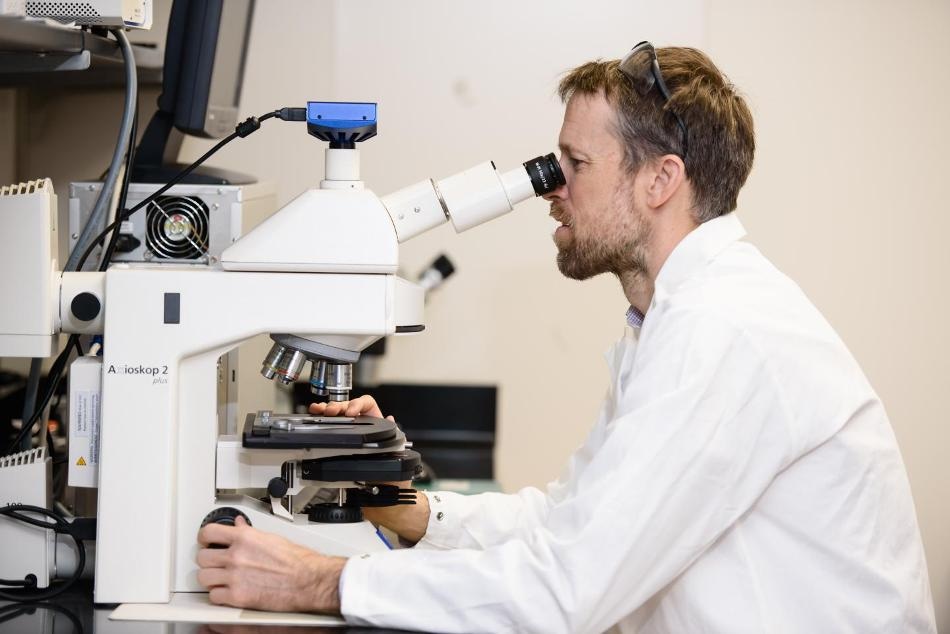Feb 19 2018
According to a recent study published in the journal Science Advances, dust that blew into the North Pacific Ocean could help illuminate why the Earth’s climate cooled 2.7 million years ago.
 Alex Pullen looks through a microscope at the L.G. Rich Environmental Laboratory at Clemson University. (Image credit: Clemson University)
Alex Pullen looks through a microscope at the L.G. Rich Environmental Laboratory at Clemson University. (Image credit: Clemson University)
One of the co-authors was Alex Pullen, an assistant professor of environmental engineering and earth sciences at Clemson University.
“Why study the past? It’s a great predictor of the future,” he said. “The findings of this study were both interesting and very unexpected.”
Researchers were fascinated by dust because when it blows off the land and into the ocean, the iron in it fertilizes the water in the same manner as farmers do their fields. Through photosynthesis, minute organisms that inhabit the ocean surface waters pull carbon dioxide out of the atmosphere, which typically means cooler temperatures.
The biggest surprise in the research was that precipitation, instead of dryness, was the most crucial factor for adding East Asian dust to the atmosphere and oceans leading up to the ancient climate change, Pullen said.
It may appear counterintuitive, he said, because “most people associate dust emission with aridity and deserts, not with precipitation.”
But the researchers believe they have an idea of what took place.
The monsoon precipitation deepened, and the increase caused erosion along the Tibetan Plateau and lower elevation areas adjacent to what is China today, the researchers found. The wind carried the moderately loose sediment into the North Pacific Ocean, where it probably helped spur photosynthesis.
The research concentrated on a time that marked a change between a period of high carbon-dioxide levels in the atmosphere similar to modern day and much lower levels akin to the period before the industrial revolution, Pullen said.
He continued by saying that the research helps to illustrate what caused the Earth to go into the glacial and interglacial periods that have ruled ever since.
But the findings do not indicate that humans are off the hook on warming global temperatures, Pullen said.
Researchers were dealing in geologic time– millions of years– and the geologic record is not always comprehensive enough to reflect what might have occurred in the span of a few hundred years, he said. That would be sufficient to melt the ice caps and put coastlines and islands underwater, Pullen said.
The climate in the future could look like the Pliocene Epoch, which was 5.3 million to 2.5 million years ago, said Pullen, who is a geologist.
Now we just have to figure out what the Pliocene looked like everywhere on Earth. That’s going to be difficult because the Pliocene rock record doesn’t exist everywhere. But we need to collect as much information from the Pliocene as we can to improve climate models and have a better understanding of what is in store for our future.
Alex Pullen, Co-Author
The research was an international partnership between Junsheng Nie, Wenbin Peng, and Zhao Wang of Lanzhou University in China; Pullen; and Carmala N. Garzione of the University of Rochester.
The team’s findings were drawn from comprehensive analysis of sedimentary rock in the Chinese Loess Plateau, an area of East China that has been gathering dust for a minimum of 8 million years.
David Freedman, chair of Clemson’s Department of Environmental Engineering and Earth Sciences, congratulated Pullen and the team on their efforts.
“Publishing in Science Advances is a significant accomplishment,” he said. “Dr. Pullen is helping draw positive attention to the department, boosting our reputation for excellent research.”
Science Advances is a peer-reviewed, multidisciplinary, open-access scientific journal established in early 2015 and published by the American Association for the Advancement of Science.
The article is titled, “Pre-Quaternary decoupling between Asian aridification and high dust accumulation rates.”